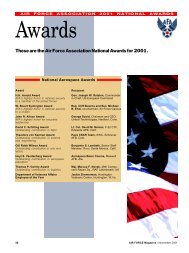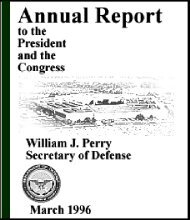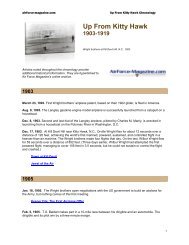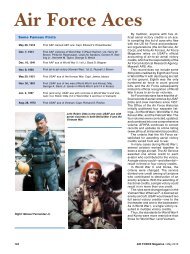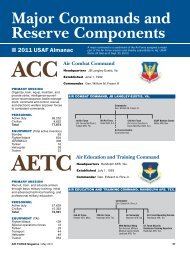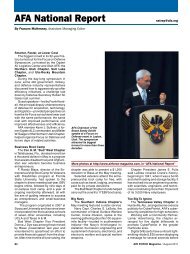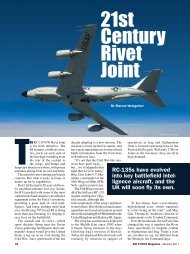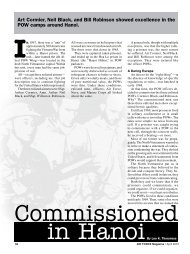1997 Annual Defense Report Table of Contents - Air Force Magazine
1997 Annual Defense Report Table of Contents - Air Force Magazine
1997 Annual Defense Report Table of Contents - Air Force Magazine
You also want an ePaper? Increase the reach of your titles
YUMPU automatically turns print PDFs into web optimized ePapers that Google loves.
Services, commanders, and leaders are sensitive to the time service members spend away from their<br />
families and are taking a number <strong>of</strong> actions to help reduce adverse impacts. The Office <strong>of</strong> the Assistant<br />
Secretary <strong>of</strong> <strong>Defense</strong> for Reserve Affairs developed a FY 1995-<strong>1997</strong> pilot program to use Reserve<br />
component forces during peacetime to reduce the active component operating tempo. Although there<br />
remains concern over the long-term impact <strong>of</strong> high personnel tempo, only localized areas <strong>of</strong> adverse<br />
impact have been noted and these are being addressed by the Services and the Joint Staff.<br />
HOUSING<br />
Secretary <strong>of</strong> <strong>Defense</strong> Perry recognized the importance <strong>of</strong> housing as a key element in the quality <strong>of</strong> life <strong>of</strong><br />
service members and their families. Dr. Perry said that there is an iron logic linking quality <strong>of</strong> life;<br />
recruiting and retention; and high mission readiness. While the United States military has reduced in size,<br />
the hazards U.S. service personnel face remain daunting. Retaining motivated, educated, and trained<br />
forces is critical to meeting future U.S. national security missions. For these reasons, improving the<br />
quality <strong>of</strong> housing for uniformed personnel is linked to combat effectiveness.<br />
Legislative Authorities Update<br />
The recent enactment <strong>of</strong> legislative authorities proposed by the Administration will allow the Department<br />
to attract private capital to help solve DoD housing problems much more quickly. The new authorities can<br />
be used individually or in combination, and will allow the Department to attract private capital and<br />
leverage appropriated dollars by at least three to one. These housing improvement authorities tools will<br />
permit loan and rental guarantees, leasing, conveyance or lease <strong>of</strong> land and facilities, direct investments,<br />
differential lease payments, and direct loans. As military construction projects are converted to<br />
privatization projects financed using the new authorities, the Department expects to use the savings to<br />
fund additional projects. These legislative authorities and projects are further described in the Business<br />
Affairs, International Programs, and Installations chapter.<br />
Family Housing<br />
Currently, one-third <strong>of</strong> military families live in military housing. About 200,000 <strong>of</strong> these government<br />
quarters require major renovation or replacement, at a cost <strong>of</strong> $20 billion. With the current level <strong>of</strong><br />
military construction funding, it will take the Department 30 years to address the $20 billion problem.<br />
Neither the cost nor the time line <strong>of</strong> current housing construction and modernization meet the challenge<br />
DoD faces. To combat this problem, the Department will couple the recently enacted legislative<br />
authorities with current family housing funds. The FY <strong>1997</strong> <strong>Defense</strong> budget included $3.1 billion for<br />
operating and maintaining 359,000 family housing units, and $1 billion for construction and improving<br />
family housing. For FY 1998, the Department has requested $3 billion to operate and maintain family<br />
housing units and $700 million for constructing and improving family housing. These funds are used for<br />
renovation or replacement <strong>of</strong> housing, depending on which is more economical. Revitalizing family<br />
housing <strong>of</strong>ten involves actually reducing a base's total housing inventory while improving its quality.<br />
While the Department has a robust program to improve on-base housing for service families, it continues<br />
to rely first on the local housing market, where about two-thirds <strong>of</strong> military families live. Families pay on<br />
average about 19 percent out-<strong>of</strong>-pocket to obtain adequate housing. As part <strong>of</strong> DoD's quality <strong>of</strong> life<br />
initiative, $20 million was added to the Department's FY <strong>1997</strong> budget request to continue funding joint<br />
public/private ventures in FY <strong>1997</strong>; Congress appropriated $25 million for this purpose.<br />
45


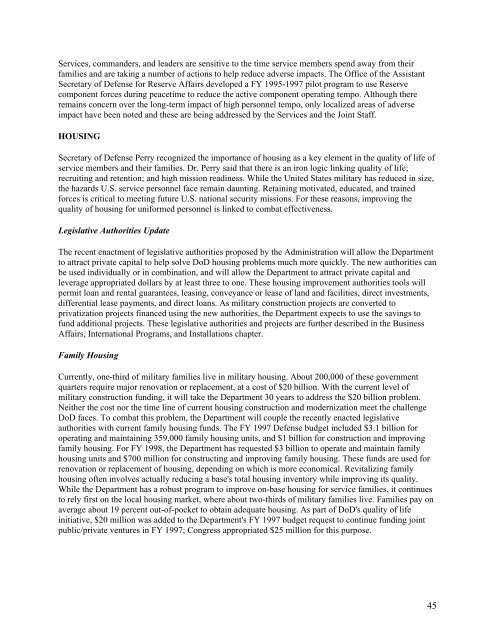
![[PDF] Foulois - Air Force Magazine](https://img.yumpu.com/13391007/1/190x253/pdf-foulois-air-force-magazine.jpg?quality=85)


